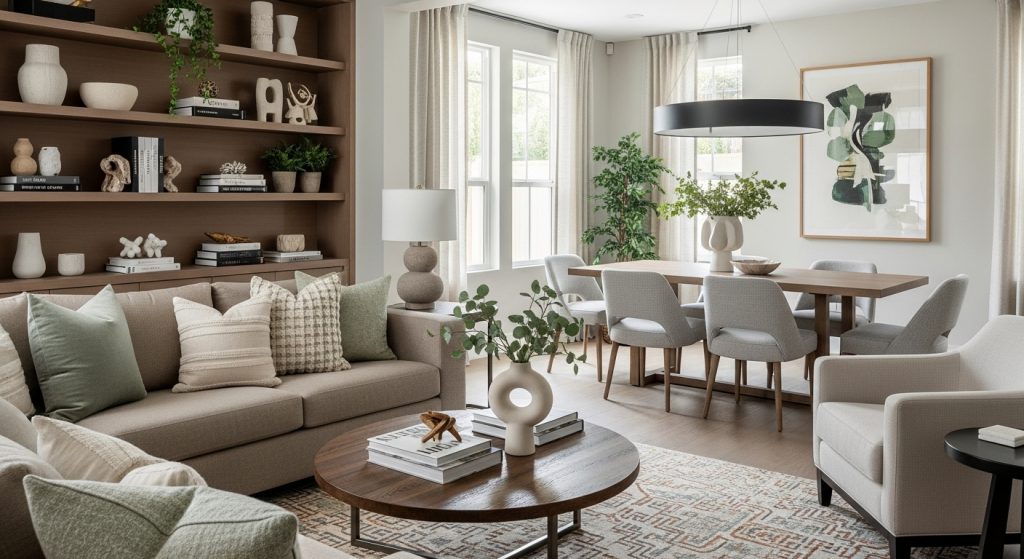Mastering interior styling tips and furniture coordination is the definitive path to creating a balanced, beautiful, and truly cohesive home decor. It is the art and science of selecting and arranging furniture, colors, textures, and accessories in a way that creates a harmonious and inviting atmosphere throughout your living space. While personal taste is subjective, certain professional principles guide the creation of interiors that feel resolved, comfortable, and effortlessly chic.

This comprehensive home design guide provides an expert framework. It explores the core concepts, offers practical matching furniture ideas (and intentional mismatching strategies), and details how to achieve a seamless flow that transforms a collection of rooms into a unified, personal sanctuary.
What is the Core Philosophy of Cohesive Home Decor?
The core philosophy of cohesive home decor is creating a unified visual narrative that flows seamlessly from room to room. It involves establishing a consistent design language through the thoughtful repetition of colors, materials, styles, or motifs. This does not mean every room must look identical. Rather, it means creating a sense of connection and harmony, ensuring that the different spaces feel like they belong to the same home.
This approach creates a feeling of calm and order. It makes a home feel more intentional, sophisticated, and restful to the eye. A cohesive design avoids the jarring effect of jumping between drastically different styles or color palettes from one room to the next. It is about crafting a holistic environment where each space complements the others, contributing to a greater, unified whole. The psychological benefits of living in a harmonious and well-ordered environment are increasingly recognized.
Why is Furniture Coordination the Foundation?
Furniture coordination is the foundation of cohesive design because furniture pieces are typically the largest and most visually dominant elements in any room. The style, scale, color, and arrangement of your furniture set the primary tone and structure for the space. If the main furniture pieces do not relate well to each other or to the room’s architecture, achieving overall cohesion becomes incredibly difficult.
Getting the furniture right provides the essential framework upon which all other decorative layers – paint, textiles, accessories – are built. It involves considering not just individual pieces but how they interact with each other and with the space they occupy. This requires a strategic approach, looking beyond immediate appeal to consider long-term harmony and function.
How Does Furniture Define a Room’s Style?
The style of the primary furniture pieces – the sofa in the living room, the bed in the bedroom, the dining table – largely defines the room’s overall aesthetic. A sleek, low-profile sofa signals a modern style. A rolled-arm sofa upholstered in floral fabric suggests a traditional or country look. Ensuring that the dominant furniture pieces within a room, and ideally across adjacent rooms, share a compatible stylistic language is crucial for cohesion.
What is the Importance of Scale and Proportion?
Scale (the size of an object relative to the space) and proportion (the size of objects relative to each other) are critical. Furniture that is too large for a room will make it feel cramped and unbalanced. Furniture that is too small can feel lost and insignificant. Achieving the correct scale involves choosing pieces that fit comfortably within the room’s dimensions and relate harmoniously to each other in size. This is particularly vital in compact homes, as discussed in small home furniture layout tips to maximize flow.
How Does Layout Impact Cohesion and Flow?
The layout, or arrangement, of furniture impacts both the visual cohesion and the functional flow of a space. A well-planned layout creates comfortable conversation areas, clear traffic paths, and a sense of balance. Poorly arranged furniture can feel awkward, block movement, and disrupt the room’s harmony. Considering how furniture placement affects sightlines and movement between rooms is also key to creating a cohesive whole-home experience.
How Do You Define Your Home’s Overall Style?
Defining your home’s overall style is the crucial first step in any furniture coordination effort. This provides a guiding vision, helping you make consistent choices about furniture, colors, and accessories. Without a clear style direction, it is easy to end up with a confusing mix of unrelated items.
How to Identify Your Personal Design Aesthetic?
Identifying your personal aesthetic involves self-reflection and research.
- Gather Inspiration: Collect images (from magazines, Pinterest, Instagram) of rooms and styles you are drawn to. Look for recurring themes in terms of color, furniture shapes, and overall mood.
- Analyze Your Preferences: Do you prefer clean lines or ornate details? Warm wood tones or cool metals? Bright colors or muted neutrals? Formal symmetry or relaxed asymmetry?
- Consider Your Lifestyle: Your style should also be practical for how you live. A home with young children might favor durable materials and comfortable forms over delicate antiques.
- Define Key Style Words: Try to summarize your preferred look with a few keywords (e.g., “modern organic,” “classic traditional,” “coastal casual,” “eclectic vintage”).
Should You Stick to One Style or Mix Them?
This is a key decision.
- Sticking to One Style: Creates a very cohesive and predictable look. It simplifies the selection process, as you have clear guidelines. Styles like Scandinavian decor rely heavily on this consistency.
- Mixing Styles (Eclecticism): Can create a more unique, personal, and collected-over-time feel. However, it requires a more skilled eye to ensure the mix feels harmonious rather than chaotic. The key is usually to have a dominant style and introduce elements from other compatible styles as accents. For beginners, sticking primarily to one defined style is often the easier path to cohesion.
How Do You Create a Cohesive Color Palette?
A cohesive color palette is one of the most powerful tools for unifying a home’s decor. It involves selecting a limited range of colors and using them consistently, albeit in different proportions, throughout the different rooms. This creates a visual thread that ties the spaces together.
What is the 60-30-10 Rule?
The 60-30-10 rule is a classic interior design guideline for distributing color within a single room, but its principle can be applied across a home.
- 60% Dominant Color: Typically used for walls and large expanses. Often a neutral.
- 30% Secondary Color: Used for furniture, rugs, or curtains. Should contrast or complement the dominant color.
- 10% Accent Color: Used sparingly in accessories like pillows, artwork, or small decor items to add pops of interest. Establishing this hierarchy within each room, while using a related palette across rooms, creates both individual room identity and overall home cohesion.
Why Start with a Neutral Base?
Starting with a neutral base for walls (white, gray, beige) and possibly large furniture pieces (sofa, bed) provides maximum flexibility. Neutrals create a calm backdrop. They allow accent colors and furniture details to stand out. They also make it easier to transition between rooms and adapt the decor over time without requiring major repainting. Our guide on how to blend wood console tables with neutral color palettes explores the power of neutrals.
How to Use Accent Colors to Connect Spaces?
Use your chosen accent colors strategically to create connections between adjacent spaces. An accent color used on pillows in the living room could reappear in the artwork in the dining room or the towels in a nearby powder room. This repetition of color creates a subtle but effective visual link, guiding the eye and reinforcing the sense of a unified design scheme.
What Are Effective Furniture Coordination Strategies?
Effective furniture coordination involves selecting pieces that relate to each other harmoniously, even if they are not part of a matching set. This requires looking at the “DNA” of each piece – its style, material, finish, and form – and finding common threads or pleasing contrasts.
Matching Sets: The Pros and Cons
Buying a matching furniture set (e.g., a sofa, loveseat, and armchair all in the same style and fabric) is the simplest way to achieve coordination within a single room.
- Pros: Guarantees a cohesive look, simplifies shopping.
- Cons: Can sometimes lack personality, may not perfectly fit the room’s layout or functional needs, offers less flexibility for future updates. While easy, relying solely on matching sets throughout the home can feel monotonous.
How to Mix Furniture Styles Successfully?
Mixing furniture styles requires finding unifying elements. Successfully blended rooms often adhere to these principles:
- Shared Color Palette: Different style pieces upholstered in the same or complementary colors feel connected.
- Consistent Finish: Mixing styles is easier if the wood finishes or metal tones are consistent or deliberately complementary.
- Similar Scale: Ensure the pieces feel proportional to each other, even if their styles differ. A delicate antique chair might look lost next to a massive modern sofa.
- The 80/20 Rule: Aim for about 80% of your furniture to be in your dominant style, and use the remaining 20% for contrasting accent pieces.
How Do You Coordinate Different Wood Tones?
Coordinating different wood tones is a common challenge. The key is usually to pay attention to the undertones (warm vs. cool).
- Match Undertones: Pairing woods with similar undertones (e.g., warm red oak with warm cherry) creates a harmonious blend.
- Create High Contrast: Pairing a very light wood (like maple) with a very dark wood (like ebony) can create a deliberate, modern contrast.
- Choose a Dominant Tone: Select one primary wood tone for the largest pieces and use others sparingly as accents.
- Use a “Bridge” Element: A rug or artwork that contains both wood tones can help tie them together visually. Our guide on mixing wood tones between console tables and nightstands provides specific examples.
What Are the Rules for Mixing Metal Finishes?
Mixing metal finishes (like gold, silver, black, brass) is a popular trend that adds depth and a collected feel. The key principles are:
- Establish Dominance: Choose one metal finish to be the primary one, featured on larger elements like lighting fixtures or furniture frames.
- Use Accents: Introduce one or two other metal finishes in smaller doses through accessories like picture frames, lamp bases, or hardware.
- Consider Texture: Mix different textures (polished, brushed, hammered, matte) to add interest.
- Repeat: Ensure each metal finish appears at least twice in the space to feel intentional. Our guide on mixing metallic tones: silver and gold console decor offers detailed strategies.
How to Create Harmony with Materials and Textures?
Creating harmony involves balancing the visual and tactile qualities of different materials. Mix hard surfaces (wood, metal, stone) with soft textures (upholstery, rugs, throws). Contrast smooth finishes (lacquer, polished metal) with rougher textures (reclaimed wood, woven baskets, natural linen). This layering of materials prevents the room from feeling flat and adds a crucial layer of sensory richness. The effective use of texture is a hallmark of professional interior styling.
How Do Accessories and Styling Complete the Look?
Accessories and styling are the final, crucial layers that complete the cohesive home decor. These smaller elements – textiles, artwork, lighting, and decorative objects – are where you can reinforce your chosen style, introduce accent colors, and add personality. They are the finishing touches that tie everything together.
What is the Role of Textiles (Rugs, Curtains, Pillows)?
Textiles play a massive role in creating cohesion and atmosphere.
- Rugs: Anchor seating areas, define zones, introduce color and pattern, and add softness underfoot. Choose a rug that incorporates colors found elsewhere in the room.
- Curtains: Frame windows, control light, and add texture and color. The style of the curtains should align with the overall room aesthetic.
- Pillows and Throws: Are the easiest way to introduce accent colors and patterns. Use them to tie together the colors of the furniture, rug, and artwork.
How Does Artwork and Wall Decor Contribute?
Artwork and wall decor are essential for adding personality and reinforcing the style. Choose pieces that fit your chosen aesthetic and color palette. The frames should also be considered – coordinating frame styles or finishes across different rooms creates a subtle but effective link. Mirrors are also powerful tools, reflecting light and views, and adding a decorative element through their frames.
Can Lighting Fixtures Act as Unifying Elements?
Yes, lighting fixtures can be powerful unifying elements. Using fixtures from the same design family or with the same finish (e.g., all brass fixtures or all black modern fixtures) throughout an open-plan space or even across multiple rooms creates a strong sense of cohesion. Layering different types of lighting (ambient, task, accent) is also crucial for creating a functional and inviting atmosphere.
How Do You Ensure Cohesion Between Different Rooms?
Ensuring cohesion between different rooms is the ultimate goal of a unified home design. This involves creating smooth transitions and repeating key elements to create a sense of flow and connection, even if the rooms serve different functions or have slightly different moods. Our guide on how to keep entryway and bedroom furniture cohesive addresses this directly.
How to Create Smooth Transitions?
Create smooth transitions by using consistent flooring throughout adjacent spaces where possible. Maintain a consistent wall color or use shades from the same color family. Ensure architectural elements like trim and doors are consistent. Avoid abrupt changes in style or color palette right at the doorway between rooms.
Why is Repeating Colors and Materials So Effective?
Repeating key colors and materials is the most effective way to create a visual link between rooms. An accent color used in the living room rug could reappear in the dining chair upholstery. The wood tone of the kitchen cabinets might be echoed in the living room console table. The metal finish of the bathroom fixtures could match the hardware in the hallway. These subtle repetitions create a subconscious sense of harmony.
What is the Importance of Consistent Finishes?
Maintaining consistent finishes on architectural elements provides a unifying backdrop for your decor. This includes:
- Flooring: Using the same flooring material across connected spaces creates excellent flow.
- Trim and Moldings: Keeping the style and color of baseboards, crown molding, and window trim consistent.
- Interior Doors and Hardware: Using the same style of doors and door handles throughout. Our guide on choosing the right finishes for consistent home decor highlights the impact of these foundational choices.
Conclusion
Mastering interior styling tips and furniture coordination is the key to crafting a truly harmonious home. It is a thoughtful process that goes beyond simply filling rooms with furniture. By defining your style, creating a cohesive color palette, strategically coordinating furniture pieces through shared elements, and layering in unifying accessories and finishes, you can create a cohesive home decor that feels balanced, beautiful, and deeply personal. This home design guide provides the foundational principles, empowering you to transform your living space into a unified sanctuary that reflects your unique taste and enhances your daily life.











